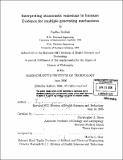| dc.contributor.advisor | Christopher A. Shera. | en_US |
| dc.contributor.author | Kalluri, Radha | en_US |
| dc.contributor.other | Harvard University--MIT Division of Health Sciences and Technology. | en_US |
| dc.date.accessioned | 2008-01-10T17:27:45Z | |
| dc.date.available | 2008-01-10T17:27:45Z | |
| dc.date.copyright | 2006 | en_US |
| dc.date.issued | 2006 | en_US |
| dc.identifier.uri | http://dspace.mit.edu/handle/1721.1/35547 | en_US |
| dc.identifier.uri | http://hdl.handle.net/1721.1/35547 | |
| dc.description | Thesis (Ph. D.)--Harvard-MIT Division of Health Sciences and Technology, 2006. | en_US |
| dc.description | Includes bibliographical references (p. 110-118). | en_US |
| dc.description.abstract | Healthy ears generate sounds known as otoacoustic emissions that can be evoked and measured in the ear-canal using small, low-noise microphones. The ability to measure acoustic signals that originate within the cochlea provides noninvasive access to what in humans is an almost inaccessible organ. Although otoacoustic emissions (OAEs) are frequently used as noninvasive probes of cochlear function in both the clinic and the laboratory, their utility is limited by incomplete knowledge of their generating mechanisms. A recently proposed model suggests that most OAEs are mixtures of -emissions arising by two fundamentally different mechanisms: 1) nonlinear distortion induced by cochlear traveling: waves and 2) linear reflection 6f those waves from pre-existing micromechanical impedance perturbations. The model predicts that OAEs generated by wave-induced perturbations manifest a phase that is nearly-frequency invariant whereas OAEs generated by reflection from pre-existing perturbations manifest a phase that rotates rapidly with frequency. The model suggests that the relative contribution from each mechanism to any emission measurement depends on factors such as the type and intensity of the evoking stimulus. | en_US |
| dc.description.abstract | (cont.) In this thesis we tested the relationships between common OAE measurements and the two proposed mechanisms of OAE generation. We tested the two-mechanism model by measuring and comparing OAEs evoked with single tones and broad-band clicks, as well as those evoked by two-tone complexes at frequencies not contained in the stimulus, so-called distortion-product emissions. Our results indicate that click-evoked and tone-evoked OAEs, previously regarded as different types of emission based on the characteristics of the stimuli used to evoke them, are really the same emission evoked in different ways. The phase characteristics of both emission types are consistent with those predicted for emissions originating by linear-reflection from pre-existing perturbations. In addition, we demonstrate that distortion-product OAEs are often mixtures of two components. By separating the two components we show that one component arises by linear reflection and the other component arises by induced distortion. Our results provide strong empirical support for the two-mechanism model of OAE generation. Since the two emission mechanisms depend on fundamentally different aspects of cochlear mechanics, measurements that isolate each emission type should improve the power and specificity of OAEs as non-invasive probes of cochlear function. | en_US |
| dc.description.statementofresponsibility | by Radha Kalluri. | en_US |
| dc.format.extent | 118 p. | en_US |
| dc.language.iso | eng | en_US |
| dc.publisher | Massachusetts Institute of Technology | en_US |
| dc.rights | M.I.T. theses are protected by copyright. They may be viewed from this source for any purpose, but reproduction or distribution in any format is prohibited without written permission. See provided URL for inquiries about permission. | en_US |
| dc.rights.uri | http://dspace.mit.edu/handle/1721.1/35547 | en_US |
| dc.rights.uri | http://dspace.mit.edu/handle/1721.1/7582 | |
| dc.subject | Harvard University--MIT Division of Health Sciences and Technology. | en_US |
| dc.title | Interpreting otoacoustic emissions in humans : evidence for multiple generating mechanisms | en_US |
| dc.type | Thesis | en_US |
| dc.description.degree | Ph.D. | en_US |
| dc.contributor.department | Harvard University--MIT Division of Health Sciences and Technology | |
| dc.identifier.oclc | 73723005 | en_US |
